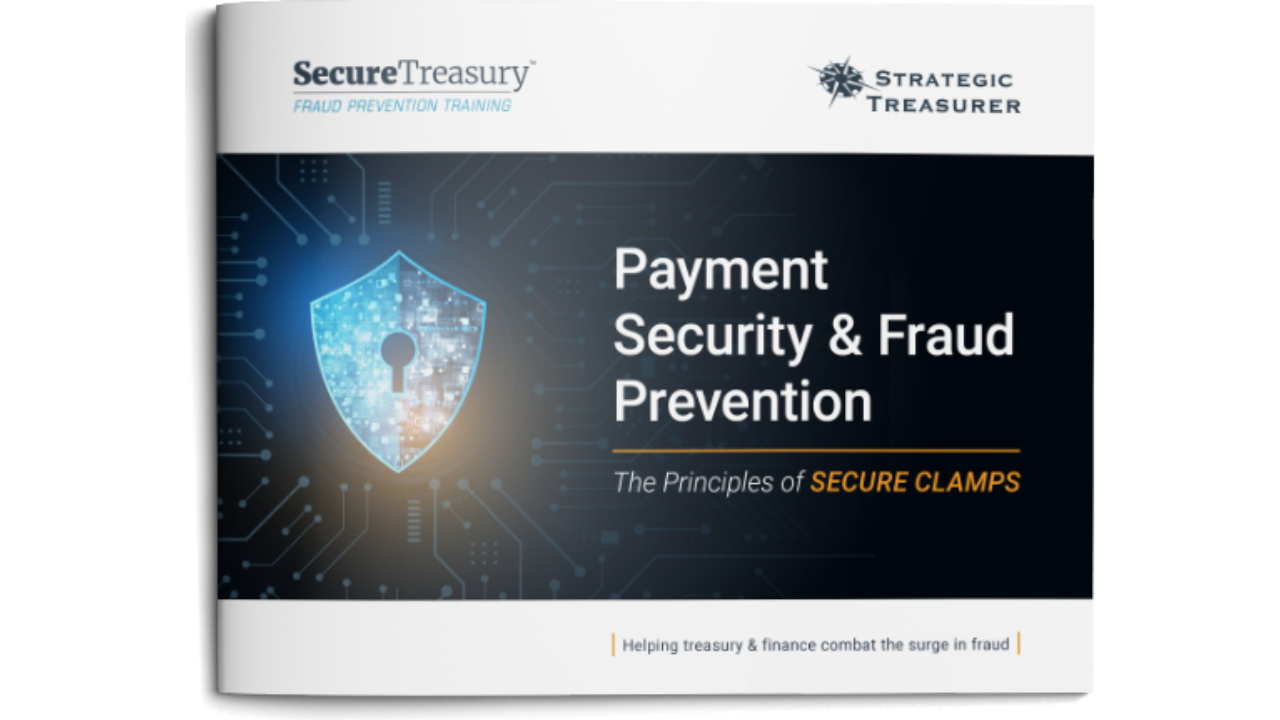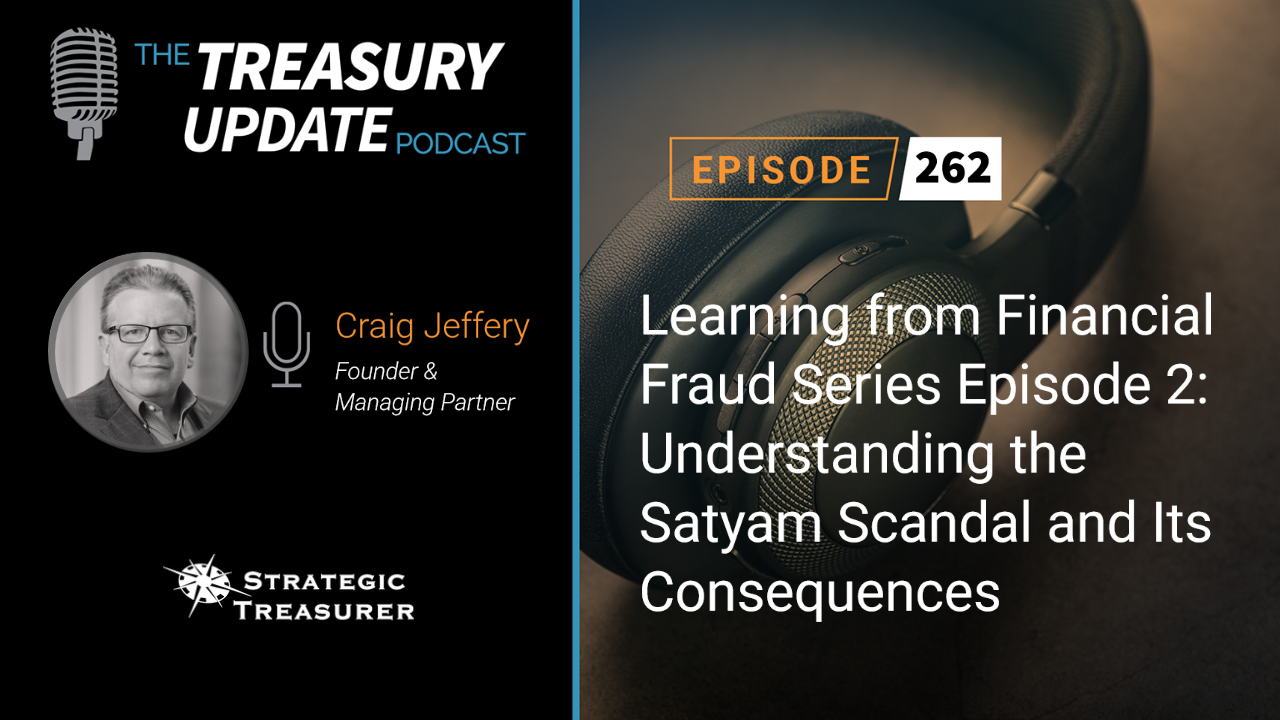
Episode 264
Learning from Financial Fraud Series Episode 3: Unraveling the Wirecard Fraud – Safeguarding Your Business
Join Craig Jeffery and Jason Campbell as they dissect the 2020 Wirecard fraud, a financial scandal involving a global fintech firm. They look at the magnitude of the deception, involving financial misstatements and fictitious transactions, and discuss the consequences for investors and creditors, as well as its impact on Germany’s financial system.
Host:
Jason Campbell, Strategic Treasurer


Speaker:
Craig Jeffery, Strategic Treasurer


Subscribe to the Treasury Update Podcast on your favorite app!
Episode Transcription - Episode # 264: Learning from Financial Fraud Series, Episode 3: Unraveling the Wirecard Fraud - Safeguarding Your Business
Announcer 00:04
Welcome to the Treasury Update Podcast presented by Strategic Treasurer, your source for interesting treasury news, analysis, and insights in your car, at the gym, or wherever you decide to tune in.
Jason Campbell 00:17
Welcome to the Learning From Financial Fraud Series on the Treasury Update Podcast. In this series, we will explore multiple major financial frauds and thefts to see how each one occurred and was kept hidden for a period of time, and we’ll dissect how it was eventually discovered, and get insight and guidance on how to prevent this type of situation from happening at other companies or your company. I’m Jason Campbell, the host of this episode, and I’m joined with Craig Jeffery, managing partner and founder of Strategic Treasurer. So let’s begin with episode number three in the series and talk a little bit about the Wirecard fraud case. And this is a little bit more about a FinTech involved in global payments and occurred back in 2020. And this kind of just you know, again, through this series, we’ve talked about Parmalat, we’ve talked about Satyam, you know, separate fraud cases. So looking forward to having this conversation with you, Craig, to talk about Wirecard. So as we start to look at this particular case, I want to just, you know, for our listeners’ perspective, kind of just walk us through is what was the situation with Wirecard in this particular fraud case.
Craig Jeffery 01:20
This happened in June of 2020. So this is more current, I think the first one we looked at in the series was Parmalot, which started in 1999, ended on the bankruptcy in 2003. So quite a few years ago, 10 years subsequent to the, the 99 was the 2009 was a situation that uncovered with Satyam, the Italian outsourcing firm. And then, you know, a little bit more than 10 years after that. So we have gaps of about 10 years, we hit Wirecard. As you said, it’s a it’s a FinTech heavily involved in global payments. So So what happened there, it’s there was massive accounting irregularities, of course, financial misstatements, these are these are general terms. But this was about like a little over 2 billion US dollars, 1.9 billion euros of fraud. And so you look in German history, this is like one of the largest accounting scandals. But this also involves what we might refer to as visual kiting, I know that’s not a term, people can look it up. It’s not a real term. Kiting is where you’re where you’re moving money between accounts. And because there’s delays or inefficiencies in the system, this work better in days of checks, like you deposit it, and someone may grant you availability, before the check clears on the original account. And so there were people who would kite checks or be making checks, pay between these different organizations, different entities, and continue to create this high velocity activity, which made it you know, funds would clear and the bank would end up be being out the money eventually, when you know, like that the musical chairs game when the music stops, everyone has to sit down, where’s the cash, they find out there has been a big gap because it was fictitious cash was created by organizations were people doing this kiting activity, right? You can’t, you can’t create cash, if you’re a person or a business. If you’re going to create cash, you got to be a central bank, right, you can just print it, or you can generate it electronically. But organizations can’t do that. And so the situation here, they have inflated their revenue and their assets through false records, assets, they would create all these transactions going around across the globe, sending money, sending it back, providing statements, different periods of times with different cut offs. So look like hey, we’ve got 1.9 billion more euros than we really do. And so this was the situation that created all kinds of subsidiaries, they used real partners and fake partners to to create these fake records. They fabricated banking statements, they fabricated paper banking statements and sent them along, they forged documents to full auditors. And so this is done through collusion of multiple parties, different types of creating complexity of the money flow, right? It’s so complex, nobody can understand it. Nobody can see what goes on. So it’s, Hey, we’re making good money. We’re moving a lot of activity. It’s all complex. Here’s our statements. We’re providing fake and real statements to show where the funds are. And that result in, you know, eventually, that was that was discovered. Expectation that there was problems. And that was found out to be a problem. And once it was clear, they were insolvent. It really, of course, caused the company to collapse.
Jason Campbell 04:33
So let’s dive in a little bit deeper into that into those last two points that you just expressed there. As you’re talking about the discovery of the fraud, if you don’t mind. Let’s go into it a little bit, you know, a little bit more depth about how this fraud case was brought to surface.
Craig Jeffery 04:47
As we think back over over time and as we look at some of the different records about what goes on, most organizations most research shows that different types of investigative reporting and combined with some of the external audits that were taking place, created this situation where the fraud was discovered. Do you know, Jason, that point, you know, some of the journalists, different types of research analysts were saying, I’m concerned about how they’re, they’re running this work. It’s inconsistent, these things aren’t tracking with revenue. Like, we can see the flow and velocity of funds and balances, we can see what what volume they have, what the revenues, these things aren’t, they’re not falling into the range that makes sense. Something’s out of alignment. So when when analysts do that journalists look at it, then there’s more noise, more chatter about that. And so there were different investigative reports that went on, people were investigating, say, what’s going on, that helped unveil some of the activities of what was occurring. After that, that led to more formal review by external auditors. I know there’s law enforcement activity took place to go and, you know, validate information, confirm, arrest people. So that exposed how broad the fraud was, you know, to the tune of 1.9 billion euro, so discovered by analysts, and then focused on by the auditors,
Jason Campbell 06:08
through that investigative journalism, and really going in and pulling out, you know, looking into the financials, and especially, because I mean, like, if you’re looking at it, where you’re fictitiously, showing large cash, cash balances versus in your sales revenues. And, you know, again, it goes back to when there’s smoke, there’s fire, right, and really finding out what’s the specifics and start asking, and probing and looking at some questions. So now that this discovery, because obviously, all these parties involved, it’s not a secret, right? This is a little bit more, I’m sure, you know, it’s 2020 and by that point, you know, the media ran crazy, and this, and these, you know, that timeframe, right, just a couple of years ago. So there’s got to be some fallout, and somebody, you know, had to fall on the sword for this. So let’s go and talk about, you know, the result of this fraud case here on the campaign as participants.
Craig Jeffery 06:56
Well, some of the people working in the fraud, you can see how they traveled around the world trying to escape arrest and, you know, avoid some of the complications, but that that didn’t last too well. But, but the implications for everybody who owned in the owned stock in the company owned the company suffered a pretty significant loss. Same thing with creditors, when they’re trying to recover their funds. Now, they don’t have all the funds that look like they had. So you know, creditors looking to go get the assets, the most liquid assets, and it’s a global payments type firm. If you don’t have cash, that’s, that’s what your assets are, you can’t seize buildings and equipment, you are seizing money, and the money’s not there. So that created a significant, significant problem there.
Jason Campbell 07:40
So I don’t have that piece of it. I mean, obviously, a significant problem in I mean, what what really occurred to Wirecard is an organization.
Craig Jeffery 07:47
Wirecard collapsed. They, they, they were insolvent, and you know, filed for bankruptcy.
Jason Campbell 07:53
So just not able to recover from from from this from this case of fraud, which, again, I think that’s important to kind of put out into the into our listeners, because again, it’s one of those words, this situation can cause a company to fold, and not just its investors, its participants, its employees, I mean, the the industry as a whole being kind of, you know, there’s got to be some a little bit of tarnishment from this piece of a debt, you know, in today’s world, or any, you know, even back then 2020, or, you know, whether it was 100 years ago, it’s about making sure that we’re protecting you know, that those valuable assets of an organization, especially as it relates to their cash flow. So, all big points there to really kind of put into perspective. So now that we know that, you know, this case and what occurred and the result of it, how can this type of fraud be prevented in any organization?
Craig Jeffery 08:43
That’s a good question. I know it’s a staple for this series. You know, one of the things, a couple of things that we’ve said before were having a fraud hotline. Certainly someone was feeling guilty, maybe they wouldn’t have written a confession letter, like we saw with Satyam the CEO issued a confession letter, which led to the undoing, but having a fraud hotline. Someone can feel guilty, or they can see something going on that’s not right. They can file an anonymous tip or a an attributed tip. And that creates a part of the organization that could could research it and say, Yeah, this is valid, someone’s pointing out something that’s, that’s an issue, and that can be solved. So fraud hotline would be one. Another one that we talked about was the full daily visibility to cash on a global scale. Being able to see all your cash in all your accounts on a daily basis. You’ve heard me say this before about the other ones. You know, if you’re doing this visual kind of way, you move money someplace, and then you move it to another place, you keep routing it around. So it’s like, hey, everybody’s got a half a half a billion euros in these four accounts because you keep sending around. If you’re taking a picture, you know, one day a day later, a day later, a day later. You can see hey, there’s this much money in these accounts, but it’s not at the same time. And so if you take and have a complete snapshot, whether you call it cash flash report or cash position or have a full view of liquidity, that is now here’s a snapshot across the globe, every bank, every account every currency, and you can see that trend line and change over time. And so that full daily visibility is not a nice to have, that that’s essential. And that’s the type of thing that would never let it get to this level. Right that there’d be too much movement. You’d be able to say, why are we why are we off so much? Certainly you couldn’t get the 1.9 billion euros? I just wouldn’t it wouldn’t get there. The other is this idea of confirmation of transactions. When things are moving, what’s the purpose of those? You know, there’s just a lot of items of movement that happened here that were creating noise. What’s the reason for moving those? Is it a cash management movement? Why are these occurring every day? Well, when you look and analyze the flows, that doesn’t make sense, this excessive movements for no business purpose, really, that’s the form of visual kiting, right? So it’s, it’s not truly kiting, so I can’t say that. But it’s this I’m moving money, so that we’re taking snapshots, it’s at different times, and people can see what’s there. Those are those are some of the things that I think are important and consistent with what, what we said before, except the visual kiting item. The last one that I think makes sense is this. You know, isolating information makes it hard to detect problems, right? Why do problems happen on payroll accounts, because it’s very, very much restricted, who can see those accounts for good reason. And so this idea of the principle of least privilege is a great control. But you have to understand that limiting the access to some information doesn’t mean limit the access of all information. So isolating information makes it harder to detect, because no one has a full picture of some aspects of the business, you know, cash, debt, income. Now, you may not want many people seeing the income of the organization until the financial statements are there because of the problems with making that, you know, common or known throughout the organization. But things like the cash level and the debt level across the organization, that can be restricted. But it should be you know, treasury knows that. Executive management should know where those things sit, whether those things meaning cash balances of different accounts, availability through different lines of credit, all of that should be known. So granting access to the information that makes sense. So we’ve heard the principle of least privilege is restricting it to, restricting information and an access to functionality to those who need to see something or do something. That doesn’t mean, make it so that that’s too narrow, it means the right people need to have and see that. And so that’s the key thing, making sure the right people have access to it. That should have been broader in this case.
Jason Campbell 12:41
Absolutely. Well Craig, thank you so much for giving us insight onto this Wirecard fraud case here. And, and in really, in this series of learning from financial fraud. And to our listeners, we hope that you’re able to enjoy this episode within the series here and and hopefully, this fraud case taught us a little something to ensure that we have the proper controls in place to ensure that we don’t have a situation where you lose 1.9 billion euros at any given time. So but for our listeners, thank you so much. We really appreciate you guys, and hopefully you guys are enjoying this series. We look forward to having you guys also tune into any of our episodes on the Treasury Update Podcast. Until next time, take care.
Announcer 13:24
You’ve reached the end of another episode of the Treasury Update Podcast. Be sure to follow Strategic Treasurer on LinkedIn. Just search for Strategic Treasurer. This podcast is provided for informational purposes only, and statements made by Strategic Treasurer LLC on this podcast are not intended as legal, business, consulting, or tax advice. For more information, visit and bookmark StrategicTreasurer.com.
Related Resources
The Satyam scandal sent shockwaves through the industry, revealing a web of deceit within the renowned Indian IT services company that ultimately led to its collapse in 2009. By understanding the details shared in this case study, you will be better equipped in your role to safeguard your business against similar fraudulent practices. Listen in as Jason Campbell and Craig Jeffery discuss key takeaways from this scandal.








